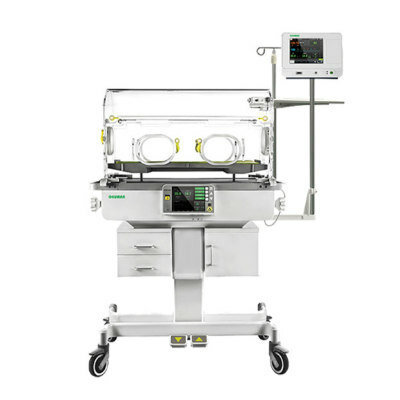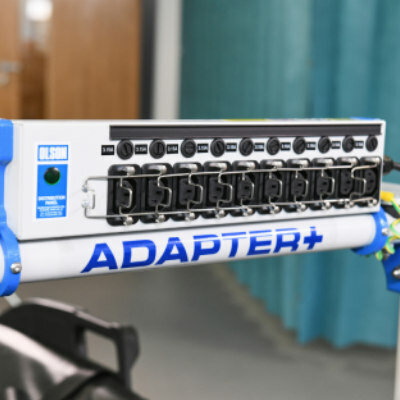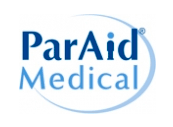New Monitors Bring 4K to the Medical Industry
|
By HospiMedica International staff writers Posted on 25 Oct 2015 |

Image: The Sony 55-inch 4K monitor (Photo courtesy of Sony).
Two new 4K medical-grade monitors provide unparalleled clarity, resolution, and detail during surgical procedures, making them ideal for hospitals, surgical centers, clinics, and other medical facilities.
The Sony (Tokyo, Japan) 31-inch (LMD-X310MD) and 55-inch (LMD-X550MD) 4K monitors feature a unique slender chassis and front bezel to provide edge-to-edge screen protection and corner-to-corner uniformity, while reducing glare and reflection. An added feature, OptiContrast technology, replaces the layer of air between the panel and the glass with a layer of resin specially formulated to match the refractive properties of the glass; this helps establish dark backgrounds for high-contrast images, even in brightly lit rooms. It also reduces glare and reflection and helps eliminate internal dew condensation.
The monitors feature an extremely wide gamut of colors which results in higher contrast and more accurate color reproduction. Both models offer Quad view picture display, so surgeons can see four full high definition(HD, 1920 x 1080) images at the same time. Users can also select different display modes, including Mirror Image, Side-by-Side, Picture-in-Picture (PIP), and Picture-out-Picture. Zoom control allows enlarging a 4K image without experiencing the pixilation normally associated with lower resolution technologies.
Images can also be adjusted using the advanced image multiple enhancer (AIME), a technology that lets users enhance structure and color for more comfortable viewing. A field-programmable gate array (FPGA) board improves visibility and features in four contrast and eight color modes. Sony is also developing of a line of 4K products to create compatibility among visualization technologies and other devices in the medical workflow, including a 4K medical grade recorder, a 4K video over IP converter, and a content management system that will allow surgeons to store, access and share 4K and HD video, still images, and documents with easy access to them throughout a hospital network.
“4K provides the highest resolution available today for surgery, giving physicians and their teams advanced visualization with virtually no pixilation, especially during up-close viewing,” said Julie Holodak, senior marketing manager at Sony’s Medical Systems Division. “4K technology gives a better view of general anatomy and blood vessels, allowing nurses, clinicians, and surgeons to see in far more detail than even possible with HD. This is important for minimally invasive and general surgery procedures, and for more immersive education and training.”
The increased number of pixels in a 4K image provides a sharper, more detailed image with four times the resolution of HD, resulting in enhanced clarity, higher contrast, and more accurate color reproduction.
Related Links:
Sony
The Sony (Tokyo, Japan) 31-inch (LMD-X310MD) and 55-inch (LMD-X550MD) 4K monitors feature a unique slender chassis and front bezel to provide edge-to-edge screen protection and corner-to-corner uniformity, while reducing glare and reflection. An added feature, OptiContrast technology, replaces the layer of air between the panel and the glass with a layer of resin specially formulated to match the refractive properties of the glass; this helps establish dark backgrounds for high-contrast images, even in brightly lit rooms. It also reduces glare and reflection and helps eliminate internal dew condensation.
The monitors feature an extremely wide gamut of colors which results in higher contrast and more accurate color reproduction. Both models offer Quad view picture display, so surgeons can see four full high definition(HD, 1920 x 1080) images at the same time. Users can also select different display modes, including Mirror Image, Side-by-Side, Picture-in-Picture (PIP), and Picture-out-Picture. Zoom control allows enlarging a 4K image without experiencing the pixilation normally associated with lower resolution technologies.
Images can also be adjusted using the advanced image multiple enhancer (AIME), a technology that lets users enhance structure and color for more comfortable viewing. A field-programmable gate array (FPGA) board improves visibility and features in four contrast and eight color modes. Sony is also developing of a line of 4K products to create compatibility among visualization technologies and other devices in the medical workflow, including a 4K medical grade recorder, a 4K video over IP converter, and a content management system that will allow surgeons to store, access and share 4K and HD video, still images, and documents with easy access to them throughout a hospital network.
“4K provides the highest resolution available today for surgery, giving physicians and their teams advanced visualization with virtually no pixilation, especially during up-close viewing,” said Julie Holodak, senior marketing manager at Sony’s Medical Systems Division. “4K technology gives a better view of general anatomy and blood vessels, allowing nurses, clinicians, and surgeons to see in far more detail than even possible with HD. This is important for minimally invasive and general surgery procedures, and for more immersive education and training.”
The increased number of pixels in a 4K image provides a sharper, more detailed image with four times the resolution of HD, resulting in enhanced clarity, higher contrast, and more accurate color reproduction.
Related Links:
Sony
Latest Health IT News
- Machine Learning Model Improves Mortality Risk Prediction for Cardiac Surgery Patients
- Strategic Collaboration to Develop and Integrate Generative AI into Healthcare
- AI-Enabled Operating Rooms Solution Helps Hospitals Maximize Utilization and Unlock Capacity
- AI Predicts Pancreatic Cancer Three Years before Diagnosis from Patients’ Medical Records
- First Fully Autonomous Generative AI Personalized Medical Authorizations System Reduces Care Delay
- Electronic Health Records May Be Key to Improving Patient Care, Study Finds
- AI Trained for Specific Vocal Biomarkers Could Accurately Predict Coronary Artery Disease
- First-Ever AI Test for Early Diagnosis of Alzheimer’s to Be Expanded to Diagnosis of Parkinson’s Disease
- New Self-Learning AI-Based Algorithm Reads Electrocardiograms to Spot Unseen Signs of Heart Failure
- Autonomous Robot Performs COVID-19 Nasal Swab Tests

- Statistical Tool Predicts COVID-19 Peaks Worldwide
- Wireless-Controlled Soft Neural Implant Stimulates Brain Cells
- Tiny Polymer Stent Could Treat Pediatric Urethral Strictures
- Human Torso Simulator Helps Design Brace Innovations
- 3D Bioprinting Rebuilds the Human Heart
- Nanodrone Detects Toxic Gases in Hazardous Environments
Channels
Artificial Intelligence
view channel
AI-Powered Algorithm to Revolutionize Detection of Atrial Fibrillation
Atrial fibrillation (AFib), a condition characterized by an irregular and often rapid heart rate, is linked to increased risks of stroke and heart failure. This is because the irregular heartbeat in AFib... Read more
AI Diagnostic Tool Accurately Detects Valvular Disorders Often Missed by Doctors
Doctors generally use stethoscopes to listen for the characteristic lub-dub sounds made by heart valves opening and closing. They also listen for less prominent sounds that indicate problems with these valves.... Read moreCritical Care
view channel
Deep-Learning Model Predicts Arrhythmia 30 Minutes before Onset
Atrial fibrillation, the most common type of cardiac arrhythmia worldwide, affected approximately 59 million people in 2019. Characterized by an irregular and often rapid heart rate, atrial fibrillation... Read more
Breakthrough Technology Combines Detection and Treatment of Nerve-Related Disorders in Single Procedure
The peripheral nervous system (PNS) serves as the communication network that links the brain and spinal cord to every other part of the body. It consists of two parts: the somatic nervous system, which... Read moreSurgical Techniques
view channel
Hydrogel-Based Miniaturized Electric Generators to Power Biomedical Devices
The development of engineered devices that can harvest and convert the mechanical motion of the human body into electricity is essential for powering bioelectronic devices. This mechanoelectrical energy... Read moreWearable Technology Monitors and Analyzes Surgeons' Posture during Long Surgical Procedures
The physical strain associated with the static postures maintained by neurosurgeons during long operations can lead to fatigue and musculoskeletal problems. An objective assessment of surgical ergonomics... Read more.jpg)
Custom 3D-Printed Orthopedic Implants Transform Joint Replacement Surgery
The evolving field of 3D printing is revolutionizing orthopedics, especially for individuals requiring joint replacement surgeries where traditional implants fail to provide a solution. Although most people... Read more
Cutting-Edge Imaging Platform Detects Residual Breast Cancer Missed During Lumpectomy Surgery
Breast cancer is becoming increasingly common, with statistics indicating that 1 in 8 women will develop the disease in their lifetime. Lumpectomy remains the predominant surgical intervention for treating... Read morePatient Care
view channel
Surgical Capacity Optimization Solution Helps Hospitals Boost OR Utilization
An innovative solution has the capability to transform surgical capacity utilization by targeting the root cause of surgical block time inefficiencies. Fujitsu Limited’s (Tokyo, Japan) Surgical Capacity... Read more
Game-Changing Innovation in Surgical Instrument Sterilization Significantly Improves OR Throughput
A groundbreaking innovation enables hospitals to significantly improve instrument processing time and throughput in operating rooms (ORs) and sterile processing departments. Turbett Surgical, Inc.... Read more
Next Gen ICU Bed to Help Address Complex Critical Care Needs
As the critical care environment becomes increasingly demanding and complex due to evolving hospital needs, there is a pressing requirement for innovations that can facilitate patient recovery.... Read moreGroundbreaking AI-Powered UV-C Disinfection Technology Redefines Infection Control Landscape
Healthcare-associated infection (HCAI) is a widespread complication in healthcare management, posing a significant health risk due to its potential to increase patient morbidity and mortality, prolong... Read moreHealth IT
view channel
Machine Learning Model Improves Mortality Risk Prediction for Cardiac Surgery Patients
Machine learning algorithms have been deployed to create predictive models in various medical fields, with some demonstrating improved outcomes compared to their standard-of-care counterparts.... Read more
Strategic Collaboration to Develop and Integrate Generative AI into Healthcare
Top industry experts have underscored the immediate requirement for healthcare systems and hospitals to respond to severe cost and margin pressures. Close to half of U.S. hospitals ended 2022 in the red... Read more
AI-Enabled Operating Rooms Solution Helps Hospitals Maximize Utilization and Unlock Capacity
For healthcare organizations, optimizing operating room (OR) utilization during prime time hours is a complex challenge. Surgeons and clinics face difficulties in finding available slots for booking cases,... Read more
AI Predicts Pancreatic Cancer Three Years before Diagnosis from Patients’ Medical Records
Screening for common cancers like breast, cervix, and prostate cancer relies on relatively simple and highly effective techniques, such as mammograms, Pap smears, and blood tests. These methods have revolutionized... Read morePoint of Care
view channel
Critical Bleeding Management System to Help Hospitals Further Standardize Viscoelastic Testing
Surgical procedures are often accompanied by significant blood loss and the subsequent high likelihood of the need for allogeneic blood transfusions. These transfusions, while critical, are linked to various... Read more
Point of Care HIV Test Enables Early Infection Diagnosis for Infants
Early diagnosis and initiation of treatment are crucial for the survival of infants infected with HIV (human immunodeficiency virus). Without treatment, approximately 50% of infants who acquire HIV during... Read more
Whole Blood Rapid Test Aids Assessment of Concussion at Patient's Bedside
In the United States annually, approximately five million individuals seek emergency department care for traumatic brain injuries (TBIs), yet over half of those suspecting a concussion may never get it checked.... Read more
New Generation Glucose Hospital Meter System Ensures Accurate, Interference-Free and Safe Use
A new generation glucose hospital meter system now comes with several features that make hospital glucose testing easier and more secure while continuing to offer accuracy, freedom from interference, and... Read moreBusiness
view channel
Johnson & Johnson Acquires Cardiovascular Medical Device Company Shockwave Medical
Johnson & Johnson (New Brunswick, N.J., USA) and Shockwave Medical (Santa Clara, CA, USA) have entered into a definitive agreement under which Johnson & Johnson will acquire all of Shockwave’s... Read more
















